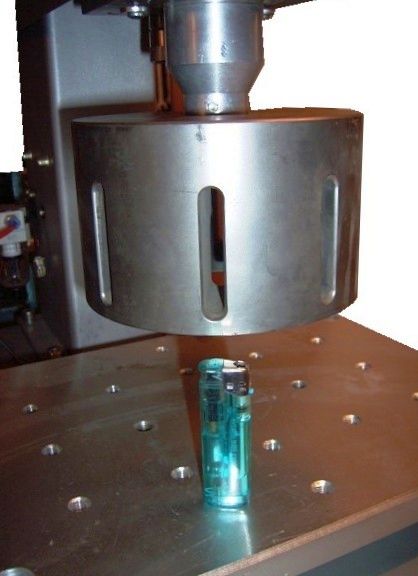Ultrasonic Titanium horn Ø 200mm, 25 kHz.
Email : info@sonic-power.com
Machined from aluminum or titanium, these horns are available up to Ø 300mm. They require higher power units to run efficiently.
The World of Ultrasonic horns – Sonotrodes
Email : info@sonic-power.com
The World of Ultrasonic horns
Ultrasonic horns is a device commonly used for augmenting the oscillation displacement amplitude provided by an ultrasonic transducer operating at the low end of the ultrasonic frequency spectrum (commonly between 15 and 100 kHz).
The device is necessary because the ultrasonic amplitudes provided by the ultrasonic transducers them selves are insufficient for most practical applications of power ultrasound.
Another function of the ultrasonic horn is to efficiently transfer the acoustic ultrasonic energy from the ultrasonic transducer into the treated media, which may be solid for example, in ultrasonic welding, cutting or soldering or liquid.
The ultrasonic horn is commonly a solid metal rod with a round transverse cross-section and a variable-shape longitudinal cross-section – the ultrasonic rod horn. Another group includes the ultrasonic block horn, which has a large rectangular transverse cross-section and a variable-shape longitudinal cross-section, and more complex composite horns. The devices from this group are used with solid treated media. The length of the device must be such that there is mechanical resonance at the desired ultrasonic frequency of operation – one or multiple half wavelengths of ultrasound in the horn material, with sound speed dependence on the ultrasonic horn’s cross-section taken into account. In a common assembly, the ultrasonic horn is rigidly connected to the ultrasonic transducer using a threaded stud.
Ultrasonic horns may be classified by the following main features: Longitudinal cross-section shape – stepped, exponential, conical, catenoidal, Transverse cross-section shape – round, rectangular, Number of elements with different longitudinal cross-section profile – common and composite.
A composite ultrasonic horn has a transitional section with a certain longitudinal cross-section shape (non-cylindrical), positioned between cylindrical sections.
Frequently, an ultrasonic horn has a transitional section with a longitudinal cross-section profile that converges towards the output end. Thus, the ultrasonic horn’s longitudinal oscillation amplitude increases towards the output end, while the area of its transverse cross-section decreases. Ultrasonic horns of this type are used primarily as parts of various ultrasonic instruments for ultrasonic welding, soldering, cutting, making surgical tools, molten metal treatment, etc. Converging ultrasonic horns are also commonly included in laboratory liquid processors used for a variety of process studies, including ultrasonic sonochemical, ultrasonic emulsification, ultrasonic dispersing and many others.
Maximum achievable ultrasonic amplitude depends, primarily, on the properties of the material from which an ultrasonic horn is made as well as on the shape of its longitudinal cross-section.

